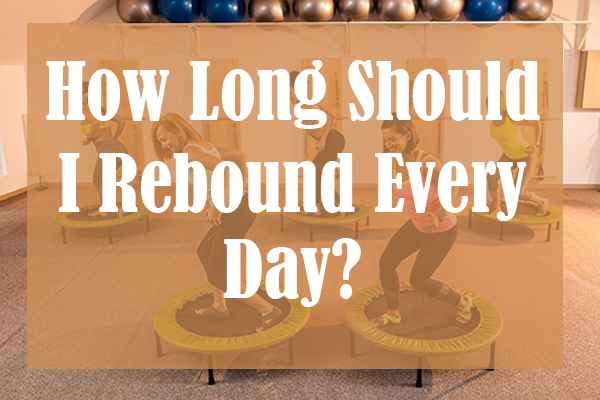- You are here:
- Home »
- Blog »
- Health
- » How Long Should I Rebound Every Day?

How Long Should I Rebound Every Day?
Once you’re past the beginner’s stage into rebounding, we’d recommend a 20-minute exercise every day. According to NASA, a 20-minute rebounding session can be as effective as a 30-minute jog.
Whether you’re the parent of four or you run your own business, we’re certain you can take time off to rebound. It is a great way to have fun with your kids. If you don’t have kids, it’s still a great way of de-stressing after a long day at work.
How Often Should I Rebound?

For the answer to this question, you should go back to the title of this article. Yes, you read it right. For an effective workout, you have to rebound every day. When it comes to rebounding, a lot of excuses become invalid. It is an exercise that knows no age limit and can be done at any time and anywhere.
For best results, you should rebound several times during the day. Later in this article, we will share a more comprehensive routine you can stick with. For now, let’s answer the question that must be nagging your mind…
Why Should I Rebound Every Day?

By now, you probably know the benefits of rebounding already. Nonetheless, let’s do a quick recap. It is a great way to get in good shape. It improves the cardiovascular system, boosts the immune system and reduces cellulite.
But that isn’t all. Rebounding is also known to relieve the mind of stress and improve a person’s posture. It is psychologically proven that good posture can have a significant impact on a person’s confidence level in any social setting.
Moreover, rebounding is unlike any other workout. You can even buy your own trampoline and work out in the backyard every day. It also eliminates the need to waste several hours in the traffic on the way to the gym.
Many health and fitness experts recommend rebounding for countless reasons. What we shared above is only a drop in the ocean.
How Many Minutes a Day Should I Rebound?

Before you start a rebounding routine, we strongly advise you to consult with a physician. It is essential that you do so to ensure that your body is fit enough to start rebounding.
A good workout routine is one that builds up gradually. At the beginning of this article, we recommended a 20-minute workout every day. However, we do not advise you to rebound for 20 minutes from day 1. Not for 20 minutes straight at least.
As a beginner, you should aim to do a 20-minute session every day. However, this session can be broken down into several mini-sessions throughout the day. This way, you won’t overstrain your muscles and you will develop a committed routine.
If you are overweight (we’re not judging!), we recommend that you start with one minute. By this, we mean you should rebound for one whole minute without a break. After taking a break for about a minute, you resume rebounding for another whole minute. Do this until you have rebounded for 4 minutes in that session. Then you repeat this 5 times during the day. This way, you will have rebounded for 20 minutes, every day.
However, if you have already had training in the past, your body is ready to take on about 2 minutes of non-stop rebounding. So you take a break from rebounding only after 2 whole minutes. Repeat this two more times during that session and 4 more times throughout the day.
As a beginner, your entire workout should only consist of several mini-sessions. Do this several times during the day, perhaps, before meals. In fact, one of the most effective times to rebound as recommended by experts is before breakfast. Doing this is said to be a great way to lose weight.
If you are fit and rebounding to remain healthy, you can rebound for 5 whole minutes. After these 5 minutes have passed, you can take a break of a couple of minutes before you rebound for another 5 minutes. Since your mini-session is 10-minutes long, you can repeat this once more during the day.
Once you’ve passed the beginner’s stage, you are ready to start rebounding for 20 minutes straight. You can do this twice a day if you want. But make sure you do it at least once, every day.
What Should I Keep in Mind Before Rebounding?

Without a doubt, rebounding can be a great way to have fun with your kids. But that does not mean you can use the same trampoline they use for fun, for your workout. Rebounding requires a special rebounder mini trampoline that is easily available for purchase. In fact, these mini trampolines can be used by your kids as well even though you can’t use theirs. So make sure you ask for the right trampoline before you make that purchase.
The best part about rebounding is that it is so convenient you can even do it in your backyard. Some people do it whenever they’re free. Even in their day clothes! However, for a good workout, we would recommend that you wear appropriate clothing. What we mean by appropriate is that it should be comfortable and fairly tight. Loose-fitting clothes may not be the smartest choice.
One very common mistake people make while rebounding is that they go overboard with their pace. Pace here refers to how fast you jump on the trampoline. The right way to do it is to have a challenging pace, but make sure it is slow enough for you to still be able to hold a conversation with someone.
Rebounding doesn’t require hiring a babysitter for the kids or getting dressed and driving all the way to the gym. It isn’t as rigorous as most other forms of exercise either, so you can easily go overboard with your workout session. Don’t do this because, in the beginning, your goal is to build a committed routine. Start small, even if you get only 5 minutes every day. Once you’re certain you can’t go a day without rebounding, you can have 20–30-minute sessions.
Stretches before and after rebounding can also be very helpful. Stretching before rebounding can make you more flexible and improve your performance. It will also make your workout more effective. Stretching after rebounding can give you a more holistic workout session.
Finally, don’t forget to breathe while rebounding! In other words, don’t jump so fast that your breathing can’t cope with the pace.
Our Rebounder Recommendations | Our Rating | Images (click for more) |
|---|---|---|
94 | ||
93 | ||
90 |




